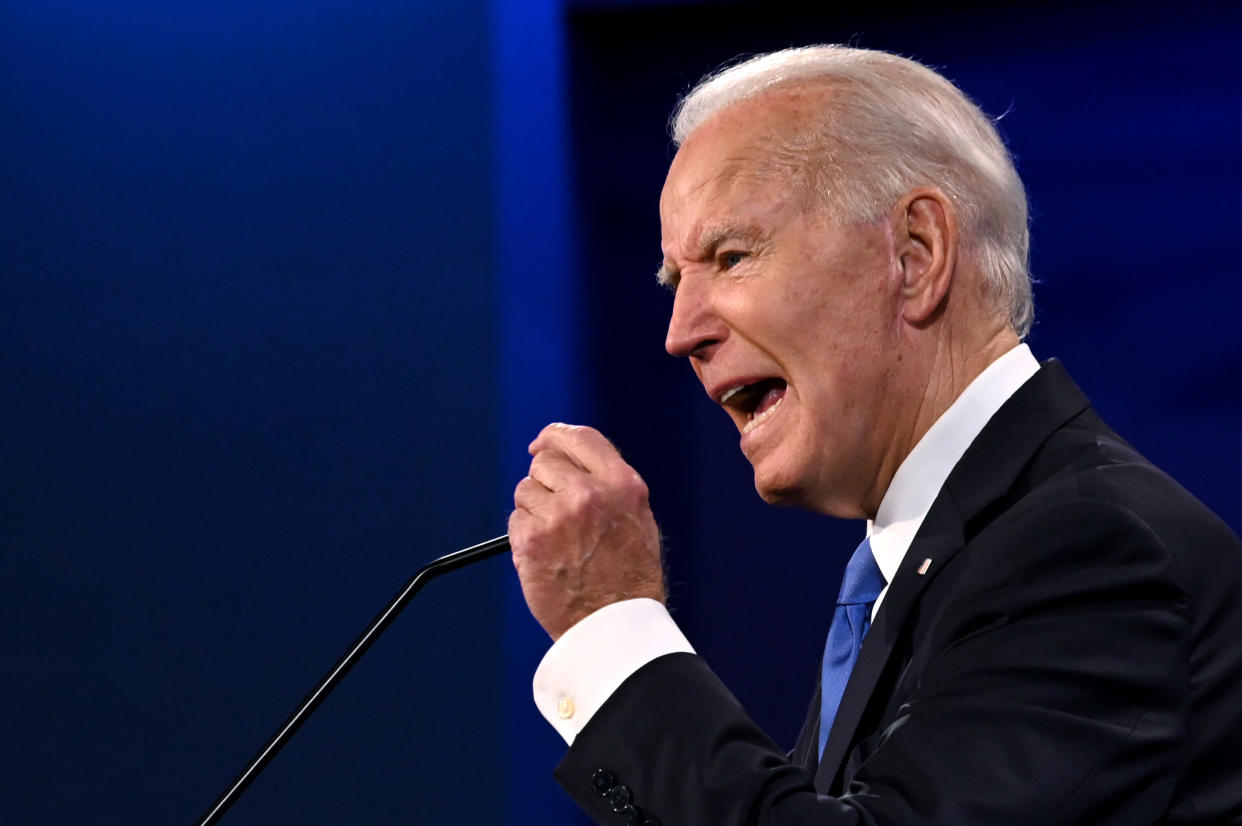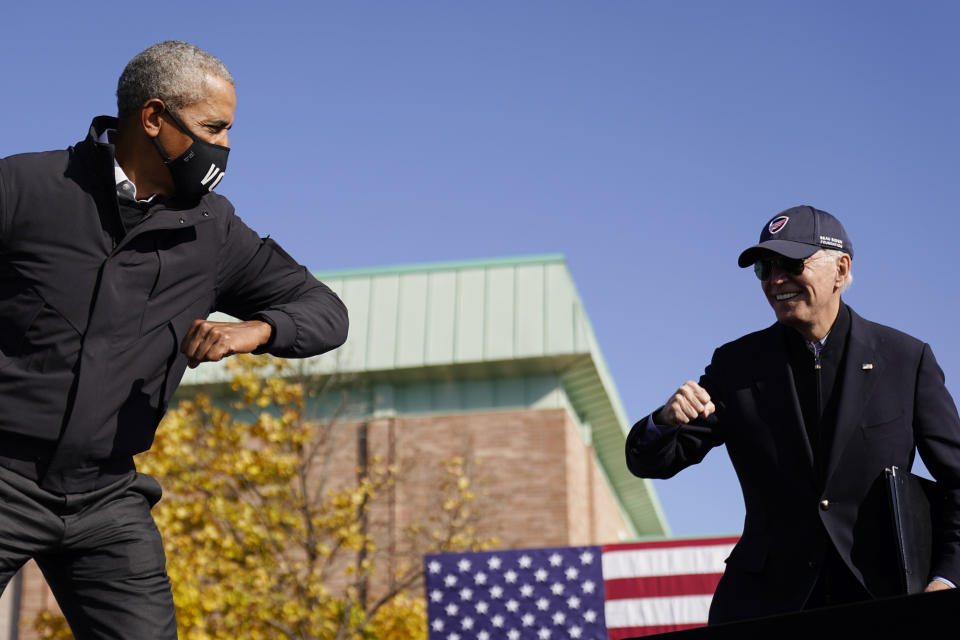How Joe Biden And Young Voters Learned To Love Each Other — At Least For Now
- Oops!Something went wrong.Please try again later.

When former Vice President Joe Biden locked down the Democratic presidential nomination with a string of primary wins in early March, he did it over the strong objections of the party’s youngest voters.
Even as Biden easily won in the states that voted later that month ― Arizona, Florida and Illinois ― Sen. Bernie Sanders (I-Vt.) still dominated with voters under the age of 45. In Illinois, a mere 29% of young people backed Biden, according to exit polls.
As the Biden campaign struggled in its appeal to young people, the candidate himself would downplay the effect of the youth vote and sometimes condescend to young activists who questioned his record. A CNN poll in May found just a third of 18- to 34-year-olds had a favorable opinion of Biden, while 55% had an unfavorable opinion. Activists affiliated with the youth-led social movements reshaping U.S. politics ― from Dreamers to Black Lives Matter to the Sunrise Movement ― viewed voting for Biden as more of a necessary chore in the push to unseat President Donald Trump than an actual opportunity.
Now, as the election enters its final days, the relationship between Biden and young people has been turned on its head, potentially providing a critical boost for him as he seeks to defeat Trump. CNN’s polling now finds its May numbers flipped: 55% of the 18-to-34-year-old cohort have a positive opinion of Biden while 32% have a negative one, an improvement almost single-handedly responsible for bringing his overall image above water. And young people are casting their ballots early in record-setting numbers in key states.
The dramatic improvement is a result not only of significant investments from Biden’s campaign ― even if it never made young voters its priority ― but also cautious compromises on immigration and climate policy by Biden in his eagerness to unite the Democratic Party and align himself with major progressive movements; a desire from left-wing activists to prove their political worth to an often-skeptical party establishment; and help from leading progressive figures like Sanders and Rep. Alexandria Ocasio-Cortez (D-N.Y.).
“He listens,” said Cristina Jiménez, co-founder of United We Dream Action, when asked why young voters had come to embrace Biden. “We’re seeing the commitments he made on immigration, on climate change. We’re seeing him move on the issues.”
Mere hours after Sanders ended his presidential bid in April, United We Dream Action was part of a coalition of progressive and youth groups to send a letter to the Biden campaign making a host of demands and promising their support in return. Many of the letter’s requests ― like asking Biden to support a “Medicare for All” plan he had been arguing against for months ― were never going to happen. Others, including giving progressives a seat at the table during the transition period to a Biden presidency, were achievable.
At the same time, though, Biden’s early general election outreach efforts were lacking. One early effort, a digital town hall moderated by a state legislator who had endorsed Biden, mostly featured questions from young people who had backed him in the primary. “That isn’t going to get it done,” Ben Wessel, the executive director of NextGen America, said in an interview at the time.

NextGen America, a super PAC funded by liberal megadonor Tom Steyer, spent more than $40 million on youth turnout efforts this cycle. The group’s early surveys found that young voters had little to no impression of Biden beyond thinking he was a run-of-the-mill career politician. Many were unaware he held even standard-issue liberal positions, like supporting gun control measures. Others mostly knew him from memes portraying Biden as an absent-minded senior citizen or as a “creep” who sniffed women’s hair.
In polls of young people, Biden always held a solid lead over Trump, who is broadly loathed by young voters. Millennials and Generation Z are markedly more liberal, and more diverse, than prior generations. But that didn’t stop Democratic officials from worrying about low turnout or the possibility a disproportionate number of young people would vote for third-party candidates.
“There was concern about third-party leakage, there was concern about young people staying home,” said John Della Volpe, a pollster who had run the Harvard Institute of Politics’ surveys of young voters and joined the Biden campaign this summer to help with its youth outreach.
Things would soon turn around, on both the policy and political fronts. The Biden campaign teamed with Sanders to create task forces on key policy issues ― and actually seemed to listen to progressive figures recommended by the youth groups, including Ocasio-Cortez, Rep. Pramila Jayapal (D-Wash.) and Sunrise Movement co-founder Varshini Prakash.
When Biden’s campaign unveiled an updated, more aggressive climate plan ― including $2 trillion in spending and a mandate for 100% clean energy by 2035 ― as part of its ‘Build Back Better’ rollout in July, the groups knew they had influence.
“Rename the Green New Deal ‘Build Back Better’ if you want,” said Alex O’Keefe, the creative director for the Sunrise Movement. “I don’t care what you call it, as long we accomplish it.” (Biden has repeatedly said he does not support exact Green New Deal proposed by Ocasio-Cortez, but the plans have clear similarities.)
Meanwhile, the Biden campaign amping up its youth voter outreach. They hired Della Volpe and Hannah Bristol, a former staffer for Sen. Elizabeth Warren (D-Mass.) and for NextGen America, to help lead outreach to younger voters. They worked with Lubna Sebastian, the national director of students for Biden, to help solidify his lead.
While the campaign engaged in the type of social media-driven stunts that can get young people’s attention – they had Biden’s granddaughters do interviews with Instagram interviewers, and even launched a Fortnite map this weekend –the goal was always to emphasize the nominee’s policy stances and empathetic nature, which they thought connected to a generation concerned with society’s most vulnerable.
“We try to bring in policy whenever possible,” Sebastian said. “A lot of them hadn’t dug into the policy before, and a lot of people were surprised.”
She added, “Young people are issues-first voters. And that’s something people don’t historically think of with young people.”
Biden’s campaign also made sure to explicitly position him as a transitional figure who could move with social movements. Della Volpe pointed to a speech Biden delivered in Philadelphia after the May 25 death of George Floyd at the hands of Minneapolis police officers as a key step in this process. (The campaign later turned the speech into a digital ad.)
“We’ve had talk before, we had protest before, we’ve got to now vow to make this at least an era of action and reverse the systemic racism with long-overdue concrete changes,” Biden said in the speech. “The action will not be completed in the first 100 days of my presidency, if I’m fortunate enough to be elected, or even in my entire term. It’s going to take the work of a generation.”
His campaign never made young people its central focus, spending millions of dollars more on advertising aimed at older voters than on the digital and TV spots it aimed at younger generations.
“The young left is important,” top Biden advisor Anita Dunn told the New Yorker in August. “But so are older white people above the age of sixty-five, because they actually gave the election to Donald Trump last time.”
NextGen America spent heavily on digital ads highlighting how Sanders, Ocasio-Cortez and other progressives could influence Biden in the White House. (Ocasio-Cortez has never officially endorsed Biden, but has talked repeatedly about the possibilities of working with him and encouraged young voters to turn out.)
“When you talk about the real-life consequences of a Joe Biden presidency, especially coupled with a Democratic Senate ― young people have never known a functioning government,” Wessel said. “It’s hard to paint a picture of that for folks who have only ever seen a cynical, self-defeating government.”
There’s still an expectation that younger voters will come out in even heavier numbers on Election Day, which is when they traditionally vote. Tom Bonier, the CEO of the Democratic data firm TargetSmart
Another key step came in August, when the Sunrise Movement helped incumbent Ed Markey ― who spent decades serving alongside Biden in Congress ― defeated Rep. Joe Kennedy III in Massachusetts’ heavily contested Democratic Senate primary. In Sunrise’s eyes, it proved their political worth to a Democratic establishment.
“I think a lot of old white men like Biden and [Senate Minority Leader] Chuck Schumer (D-N.Y.) saw [Markey’s win] and were like ‘Wow, that actually works?’” O’Keefe said. “I think they saw we were more than just zealots.”
Both sides have seen the benefits of their unspoken bargain. Biden, in his final debate with Trump, talked extensively about how his climate plan could create jobs – a favorite talking point of the Sunrise Movement. The Biden campaign has released ads attacking Trump over his policy of separating families at the border, pleasing immigration reform advocates.
Sunrise Movement members, meanwhile, have sent more than 1 million postcards urging voters in swing states to back Biden. Progressive leaders like Ocasio-Cortez are drawing big crowds to video game streams and other online events to encourage young people to vote.
As of Friday, voters under 30 years old made up 11.5% of the early votes cast compared with 9.7% at the same point in the 2016 election. The numbers were particularly strong in the battleground states of Texas, Georgia, North Carolina and Michigan.
“They’re substantially ahead of their vote share at the same point in the 2016 election,” said Tom Bonier, the CEO of the Democratic data firm TargetSmart. “There’s still an expectation that younger voters will come out in even heavier numbers on Election Day, which is when they traditionally vote.”
Della Volpe has labeled Biden’s coalition, which is reliant on both the senior citizens repelled by Trump’s behavior and young people focused on Biden’s policy proposals, the “Boomer-Zoomer coalition.” But if Biden wins, he’ll have to deliver on climate, immigration, criminal justice reform and other issues to earn the longtime loyalty of young progressives.
“The smart bet is to side with the young part of this coalition,” Wessel said. “Many of these senior voters who are voting for Joe Biden won’t come back and vote for another Democrat. And that’s OK. The question is whether you’re going to disappoint a generation who will then not show up for the next 50 years when you need them the most.”
Love HuffPost? Become a founding member of HuffPost Plus today.
This article originally appeared on HuffPost and has been updated.


